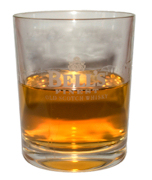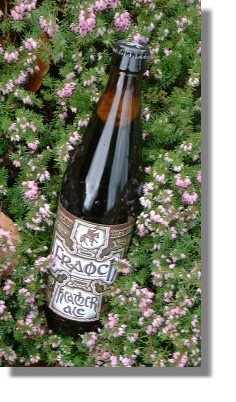

Whisky Connoisseur
Arthur J A Bell
A Rum Tale of Celtic Brews


Whisky Connoisseur
Arthur J A Bell
A Rum Tale of Celtic Brews

My story starts on the beautiful and remote island of Rum (see graphic on the right from Wikimedia by Ailith Stewart). When archaeologists were examining a site they found traces of a brewed ale in a bowl. On scientific study it turned out that the brew had been made from Heather blossom.
This confirmed the legends that had passed down the ages about the tradition of brewing ale from heather. Indeed Robert Louis Stevenson wrote a poem about such heather ale.
"From the bonny bells of heather, they brewed a drink longe syne,
Was sweeter far than honey,
Was stronger far than wine,
they brewed it and they drank it,
And lay in blessed swound,
For days and days together,
In their dwellings underground.
Stevenson's poem goes on to tell of a Scots King, who killed the Picts in battle, but he wished to capture the recipe for their Beer. A chief of the Picts and his young son were found surviving beside a cliff top. The cruel King was torturing them, and the chief promised the recipe if they killed his son quickly. The boy was hurled over the cliff, and the chief then said:"But now in vain is the torture,
Fire shall not avail,
Here dies in my bosom,
the secret of the heather ale."(You can read the whole poem at Heather Ale by Robert Louis Stevenson) The production of heather ale was not possible after the Jacobite wars. You may recall that whisky distilling was banned. Well, beer had to be brewed from that very non- Scottish plant, hops. So heather ale died out until the 1980's.
A Glasgow home brew shop owner, Bruce Williams was given an old Gaelic recipe for heather Ale by an islander. He began to test making up the brew with the flowers and started to produce the beer again.
Production was started in Argyll, but quantities were tiny. The oldest family brewery in Scotland is at Alloa, and is known as McLays. Commercial production began and this floral aromatic Beer began to win support, customers, and awards. When you have enjoyed its herbal aroma, you then feel its full firm character, with special spicy and herbal flavours. To finish, it is dry and wine like.
Not only did Stephenson write of heather ale - but so did Sir Walter Scott. He said:" If I did not taste the heather at least once a year, I think I should die." The great writer would have approved of Bruce Williams revival of this British dream. Now Bruce has not restricted himself to "Fraoch". His other drinks include Grozet which is a wheat beer brewed to a sixteenth century Scottish monks recipe. The name is the old Scots word for gooseberry and the beer is made with lager malt, wheat, bog myrtle, hops and meadow sweet. A secondary fermentation takes place with ripe Scottish gooseberries. Pale golden in colour, it is a most refreshing, crisp and fruity beer.
After Grozet Bruce Williams moved on to producing an excellent strong brown ale has the unique ingredient of spruce. The Vikings brewed spruce beers, and even Captain Cook took spruce ale on his voyages of exploration. Soon they will be picking new shoots of spruce and Scots pine for the 1998 season. A complex beer, it has a long lingering finish.
The revival of specialised brews has continued apace. As I write to you I have a glass with a deep dark 6.5% beer in front of me. This is the latest from Heather Ales. The secret ingredient in this brew is Elderberries. Apparently Celtic druids in Wales, believing there were mystical powers in the elder tree, used the berries to make magic potions. A dark fragmented brew was produced for the autumn, and passed for drinking to the people in common cups.
The Scottish Celtic Church adopted this tradition by the ninth century and over the ensuing years elderberries (pictured here) have often been used for medicinal purposes. When I heard that this new elderberry ale called Ebulum was to be brewed I was incredulous. It brought hilarious memories flooding back to me.
You see, when I was a kid I was brought up in a manse. Each year my mother, as minister's wife and woman's Guild president invited her committee for afternoon tea. Some scones and cakes -"and perhaps you'd like a glass of my home made elder berry cordial? Now the dear ladies thought this was merely a wild fruit refreshment - and walloped into the wine. Between the six of them they would consume a couple of bottles, not knowing my mother's secret. After fermentation and before bottling, my old lady, who was a doctor with a wicked sense of humour, would fortify each bottle with a glass of cognac. The result was as potent as port. My friends and I loved to see the stout pillars of the Kirk, who would never dream of letting the "demon drink" pass their lips, weaving and giggling their way down the road. They promised to come back to try the lighter Elderflower that was just maturing nicely.
I make no apology for writing about beer here. I think it is fascinating how an ancient legend, an archaeological study, a family recipe from the islands, and a go- ahead young businessman are creating a new industry. I have sat in Belgian bars consuming great fruit beers - and wondering why we do not produce beers in Scotland from our natural fruits.. Now it seems as if it is starting at last, and it is the inspiration of the ancient cultures that has got it going.
Return to Index of articles on Whisky by the Whisky Connoisseur, Arthur J A Bell
Where else would you like to go in Scotland?

